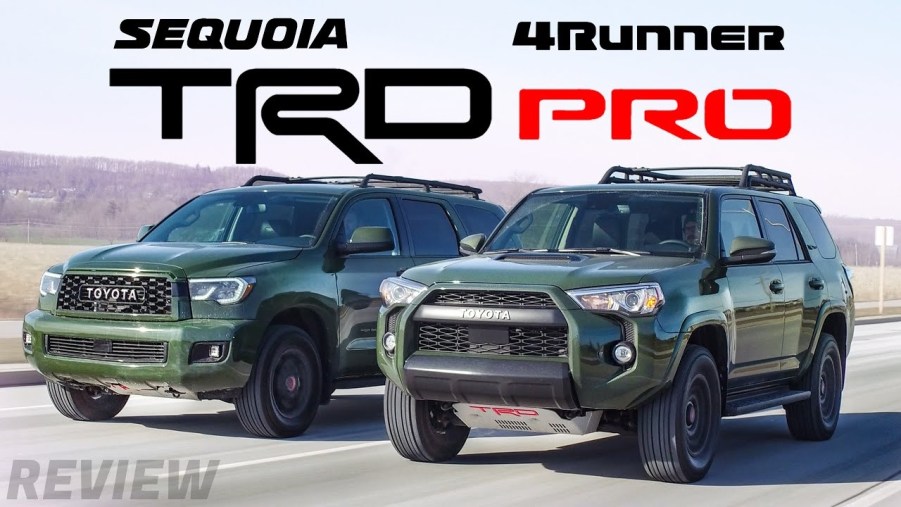
Toyota TRD Pro 3-Row SUVs: Sequoia vs 4Runner
When it comes to reliable off-road SUVs, the Toyota 4Runner has a lot to offer. New or used, the body-on-frame SUV, especially in Toyota TRD Pro trim, can keep up with icons like the Jeep Wrangler and Land Cruiser. However, family trips in the 4Runner can be inconvenienced by the tiny 3rd-row—that is, if it even offers it. TRD Pro 4Runners can’t get a 3rd row of seats. But, the Toyota TRD Pro Sequoia, an equally reliable SUV, has a 3rd-row as standard. And it can actually fit in the average garage. But in Sequoia vs. 4Runner, which Toyota TRD Pro SUV is better?
Toyota TRD Pro Sequoia and 4Runner comparison
YouTube team The Straight Pipes recently tackled the question in comparing the 2020 Toyota TRD Pro Sequoia and 4Runner.
In terms of overall design, the Sequoia and 4Runner are fairly similar. However, the Sequoia is noticeably longer than the 4Runner. With the TRD Pro trim’s roof racks, however, the two SUVs are essentially identical in height. Although, the 4Runner’s slightly lower standard height does mean its rack has two levels.

Each SUV’s TRD Pro trim also offers almost identical equipment. Both SUVs have Fox shocks, aluminum BBS wheels, off-road tires, TRD exhausts, and skid plates. However, the 4Runner’s front bumper is slightly cut-away, and its exhaust exits out the sides, rather than the rear. This gives the 4Runner better approach and departure angles than the Sequoia, despite the larger SUV having slightly more ground clearance (10” for the Sequoia, 9.6” for the 4Runner).

In Toyota TRD Pro Sequoia vs. 4Runner, the 4Runner also gets a bit more off-road tech. Both SUVs have four-wheel drive systems with transfer cases. However, 4Runner also gets multiple-terrain driving mode selection, hill start and descent control, as well as off-road-capable cruise control. And, while both the Sequoia and 4Runner have a center locking differential, only the 4Runner can lock its rear differential. The most the Sequoia can do is activate a system that uses the rear brakes to mimic a limited-slip differential.
Sequoia vs. 4Runner: off-road
Unfortunately, The Straight Pipes team weren’t able to take the SUVs off-roading. But, Motor Trend and Motor1 were. Motor1 ran the Toyota TRD Pro Sequoia and 4Runner, along with their pickup truck TRD stablemates, through several off-road courses. Of the 4 vehicles, the Sequoia came in last, whereas the 4Runner came in first.
Motor1 noted that because the Sequoia lacked the dedicated driving modes and off-road cruise control, Toyota actually held the SUV back from the most difficult courses. But the SUV’s biggest problem was its size. The TRD Pro Sequoia weighs 5,985 pounds, and at 6.7’ wide, it was difficult to maneuver around tight off-road trails. It also seemed less refined than even the pickup trucks.
The 4Runner, meanwhile, is significantly smaller and lighter. Couple that with better off-road features, and better approach/departure angles and Motor1 had no trouble conquering the test trails with it.
MT didn’t test the TRD Pro Sequoia and 4Runner back-to-back. However, as with Motor1’s reviewers, MT did find the Sequoia’s size limited it when it came to off-roading. The hood limits some obstacle sight-lines, and the SUV also scraped over rocks a few times. The 4Runner’s features, though, made off-roading almost seem easy.
However, the Sequoia vs. 4Runner debate swings back towards the larger SUV when the journey returns to pavement.
Sequoia vs. 4Runner: on-road

Inside, both SUVs have been updated with the latest infotainment systems, including Apple CarPlay and Android Auto. Toyota also now includes its safety suite as standard in every Sequoia and 4Runner. This includes features like lane-departure warning, dynamic cruise control, pedestrian detection, and automatic emergency braking. Both the infotainment and climate control systems are also controlled with buttons and knobs that are easy to turn, even while wearing gloves.

However, the interior of the Sequoia has a bit more to offer than the 4Runner’s. Although both SUVs have heated and ventilated front seats, the Sequoia has real leather seats, instead of the 4Runner’s synthetic leather ones. The TRD Pro 4Runner also doesn’t get a 3rd row, and its 2nd row is also somewhat tight on space. Meanwhile, not only are the Sequoia’s 2nd-row seats captain’s chairs, but the 3rd row can actually comfortably seat adults.
The only downside is, with all seats up, the Sequoia has less rear storage than the 4Runner. But, with the last row folded—which the Sequoia can do electronically—the Sequoia has more storage room.

The Sequoia is also better-refined than the 4Runner in some ways. Instead of halogens, the Sequoia has LED DRLs, as well as off-road Rigid LED fog lights. The Sequoia’s engine is also more powerful than the 4Runner’s. The Sequoia’s 5.7-liter V8 makes 391 hp and 401 lb-ft, whereas the 4Runner’s 4.0-liter V6 makes 270 hp and 278 lb-ft. With it, the Sequoia can tow more: 7100 pounds vs. the 4Runner’s 5000 pounds.
But the bigger difference is the transmissions. The Sequoia’s 6-speed automatic shifts much faster and smoother than the 4Runner’s 5-speed, something MT also noted in its off-road tests.
Which is the one to buy?

Ultimately, the decision between Sequoia vs. 4Runner depends on how you intended to use the SUV.
If you need more space, either for people or stuff, or are going to be regularly towing large loads, the Toyota TRD Pro Sequoia is the better option. It’s not quite as good off-road as the 4Runner, but for most people, it’s more than sufficient.

If you’re after ultimate rock-crawling capability, though, the 4Runner is the better choice. Not only does it have more off-road tech and capability, it’s also cheaper than the Sequoia. The TRD Pro Sequoia starts at $64,105; the TRD Pro 4Runner starts at $49,865.
Follow more updates from MotorBiscuit on our Facebook page.


